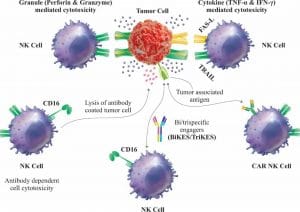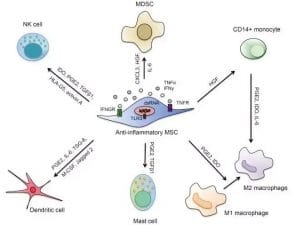What Are NK Cells and Why Do They Matter?
Natural Killer (NK) cells, often termed the “first responders” of the immune system, are a type of lymphocyte critical to innate immunity. Unlike adaptive immune cells that require prior exposure to pathogens, NK cells act swiftly to detect and eliminate virally infected cells or malignancies. Their name derives from their ability to kill without prior sensitization, a feature that positions them as sentinels against cellular dysfunction. Through receptor-mediated recognition, they distinguish healthy cells from those under stress, whether due to infection, cancer, or senescence, delivering cytotoxic granules to initiate apoptosis. Beyond destruction, NK cells secrete cytokines like IFN-γ and TNF-α, orchestrating broader immune responses.


NK Cells vs. Stem Cells: Divergent Roles, Shared Potential
While both NK cells and stem cells are pivotal in medical research, their biological roles diverge sharply. Stem cells, characterized by their self-renewal and differentiation capacity, serve as cellular raw materials for tissue repair and regeneration. In contrast, NK cells are terminally differentiated effectors of immune surveillance. However, their interplay is increasingly evident: mesenchymal stem cells (MSCs) modulate NK cell activity via paracrine signaling, while hematopoietic stem cells (HSCs) give rise to NK progenitors in bone marrow. This duality—destruction by NK cells and regeneration by stem cells—creates a yin-yang dynamic in maintaining physiological balance.
Harnessing the NK-Stem Cell Axis in Disease Therapy
The combined use of NK cells and stem cells is revolutionizing oncology and regenerative medicine. Clinical trials highlight their synergy in:
- Leukemia: CAR-NK cells derived from cord blood HSCs show 85% remission rates in refractory B-cell malignancies, with reduced graft-versus-host disease risk compared to CAR-T.
- Solid Tumors: MSC-delivered NK cell engagers enhance tumor infiltration, overcoming stromal barriers in pancreatic and glioblastoma models.
- Autoimmune Disorders: Regulatory NK subsets (NKregs), expanded via MSC coculture, suppress pathogenic T-cells in rheumatoid arthritis and multiple sclerosis.
Future Horizons: Beyond Cytotoxicity
Emerging research explores NK cells’ role in tissue homeostasis, for instance, clearing senescent cells that drive aging, and their crosstalk with induced pluripotent stem cells (iPSCs) to generate off-the-shelf immunotherapies. Challenges remain, including optimizing in vivo persistence and overcoming immunosuppressive microenvironments. Yet, as one researcher noted, “Where stem cells rebuild, NK cells protect. Together, they redefine regenerative medicine’s boundaries.”
